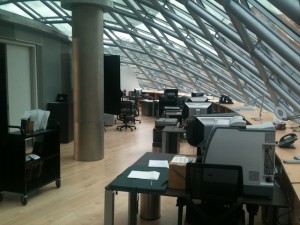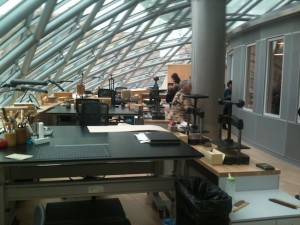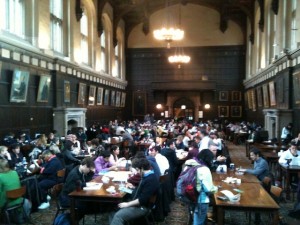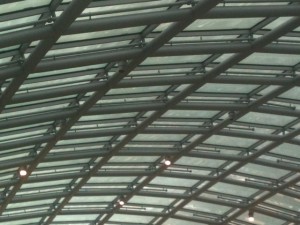On Wednesday, October 19, 2011 the Hesburgh Libraries Professional Development Committee organized a field trip to the Mansueto Library at the University of Chicago. This posting documents some of my things seen, heard, and learned. If I had one take-away, it was the fact that the initiatives of the libraries at the University of Chicago are driven by clearly articulated needs/desires of their university faculty.

Mansueto Library, the movie!
The adventure began early in the morning as a bunch of us from the Hesburgh Libraries (Collette Mak, David Sullivan, Julie Arnott, Kenneth Kinslow, Mandy Havert, Marsha Stevenson, Rick Johnson, and myself) boarded the South Shore train bound for Chicago. Getting off at 57th Street, we walked a few short blocks to the University, and arrived at 10:45. The process was painless, if not easy and inexpensive.
David Larsen (our host) greeted us at the door, gave us the opportunity to put our things down, and immediately introduced us to David Borycz who gave us a tour of the Mansueto Library. If my memory serves me correctly, a need for an additional university library was articulated about ten years ago. Plans were drafted and money allocated. As time went on the need for more money — almost double — was projected. That was when Mr. & Mrs. Mansueto stepped up to the plate and offered the balance. With its dome made of uniquely shaped glass parts and eyeball shape, the Library looks like a cross between the Louvre Pyramid (Paris) and the Hemisfèric in Valencia (Spain). The library itself serves three functions: 1) reading room, 2) book storage, and 3) combination digitization & conservation lab. For such a beautiful and interesting space, I was surprised the later function was included in the mix which occupied almost half of the above ground space.


The reading room was certainly an inviting space. Long tables complete with lights. Quiet. Peaceful. Inviting. Contemplative.
The back half of the ground-level was occupied by both a digitization and conservation lab. Lots of scanners including big, small, and huge. Their scanning space is not a public space. There were no students, staff, nor faculty digitizing things there. Instead, their scanning lab began as a preservation service, grew from there, and now digitizes things after being vetted through a committee prioritizing projects. The conservation lab was complete with large tables, de-acidification baths, and hydration chambers. Spacious. Well-equipped. Located in a wonderful place.
Borycz then took us down to see the storage area. Five stories deep, this space is similar to the storage space at Valparaiso University. Each book is assigned a unique identifier. Books are sorted by size and put into large metal bins (also assigned a unique number). The identifiers are then saved in a database denoting the location in the cavernous space below. One of the three elevators/lifts then transport the big metal boxes to their permanent locations. The whole space will hold about 3.5 million volumes (the entire collection of the Hesburgh Libraries), but at the present time there are only 900,000 volumes currently stored there. How did they decide what would go to the storage area? Things that need not be browsed (like runs of bound serial volumes), things that are well-indexed, things that have been digitized, and “elephant” folios.


When we returned from lunch our respective libraries did bits of show & tell. I shared about the Hesburgh Libraries efforts to digitize Catholic pamphlets and provide text mining interfaces against the result. Rick Johnson demonstrated the state of the Seaside Project. We were then shown the process the University of Chicago librarians were using to evaluate the EBSCOhost “discovery service”. An interface was implemented, but the library is not sure exactly what content is being indexed, and the indexed items’ metadata seems applied inconsistently. Moreover, it is difficult (if not impossible) to customize the way search results are ranked and prioritized. All is not lost. The index does include the totality of JSTOR, which is seen as a plus. Librarians have also discovered that the index does meet the needs of many library patrons. The library staff have also enhanced other library interfaces pointing them to the EBSCO service if patrons browse past two or three pages of search results. When show & tell was finished we broke into smaller groups for specific discussions, and I visited the folks in the digitization unit. We then congregated in the lobby, made our way back to the train, and returned to South Bend by 7:30 in the evening.


The field trip was an unqualified success. It was fun, easy, educational, team-building, inexpensive, collegial, and enlightening. Throughout the experience we heard over and over again how directives were taken by University of Chicago faculty on new directions. These faculty then advocated for the library, priorities were set, and goals were fulfilled. The Hesburgh Libraries at the University of Notre Dame is geographically isolated. In my opinion we must make more concerted efforts to both visit other libraries and bring other librarians to Notre Dame. Such experiences enrich us all.













